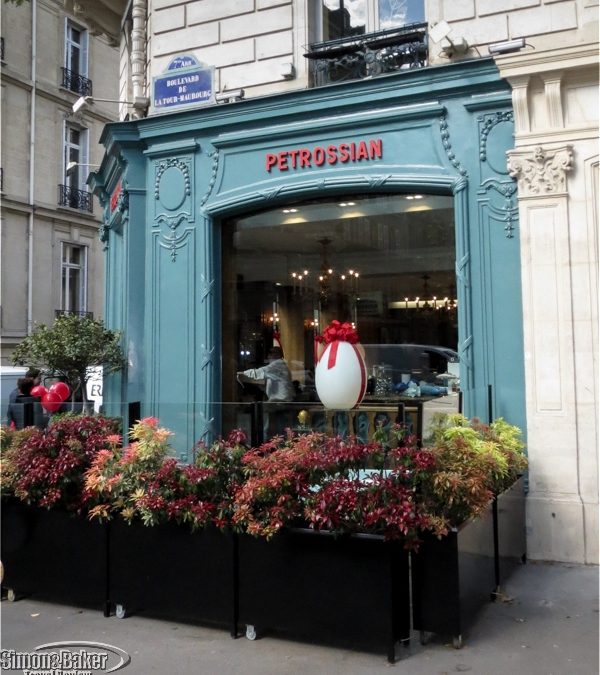
by Editor | Nov 27, 2016 | Food, Luxury Travel, Restaurants and Food
Article by Elena del Valle
Photos by Gary Cox
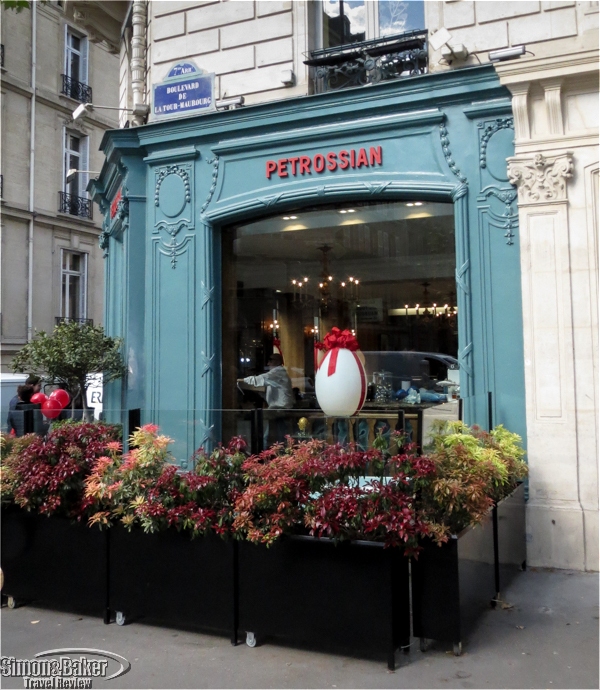
The Petrossian shop window on Boulevard de la Tour-Maubourg
Ever hear of Daurenki Impérial, Baika Impérial, Ossetra Impérial, Alverta Impérial, and Beluga Impérial? If you are a foodie you may already have an idea of what the names are, the types of farmed caviar some of which we tasted at the popular Petrossian Latour boutique in Paris, France owned by Armen Petrossian (18 boulevard de la tour Maubourg 75007 Paris, + 33 14 411 32 22, www.petrossian.fr, boutique@petrossian.fr).

Philippe Vanlacker described the types of caviar before we tasted them
On a cloudy spring morning we made our way, braving streets filled with protesters and police, to the Petrossian shop in the city’s Latin Quarter, where we sampled various products. Philippe Vanlacker, a friendly English speaking staff person, welcomed us and facilitated the caviar, Royal Salmon, and Kamtchatka Crab tasting. We liked that the only added ingredient was sea salt. There were no preservatives or additives, according to a spokesperson.
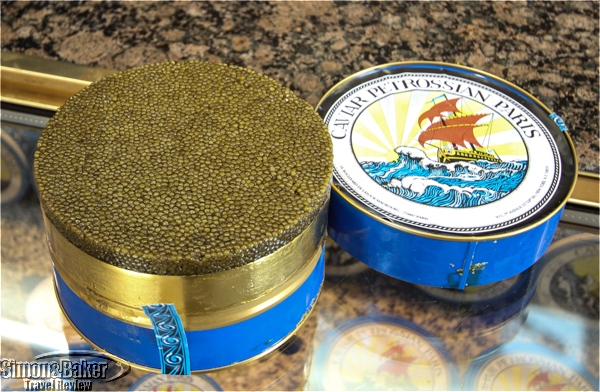
A kilogram of fine caviar
The caviar we tried, made from fish eggs and sea salt only, came from China, France, Israel, United States, and Bulgaria. The farmed salmon was from Scotland and the crab, previously frozen, was from Russia. The shop, about 600 square feet in size and staffed by eight people, appeared to be mostly for takeout purchases although it also had a few tables and a limited menu for customers wishing to have a light dish onsite. Our entire tasting was conducted while we stood facing the waist high counters without beverages of any kind.
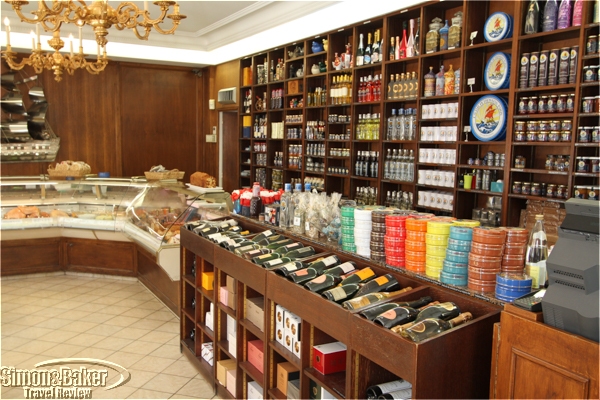
The interior of the shop
When we asked about the advantages of a store tasting a spokesperson explained by email, “When somedy (somebody) bring caviar home, it means that the man or the woman wants to seduce his/her partner or guest. But most of the time, he/she doesn’t know if they will like it. When they taste in the boutique, the can choose the caviar they have prefered (preferred) because they can taste differents (different) caviars. This is the big difference between internet, the others caviar houses and Petrossian: it’s the only place where you can taste the caviar before buying it.”
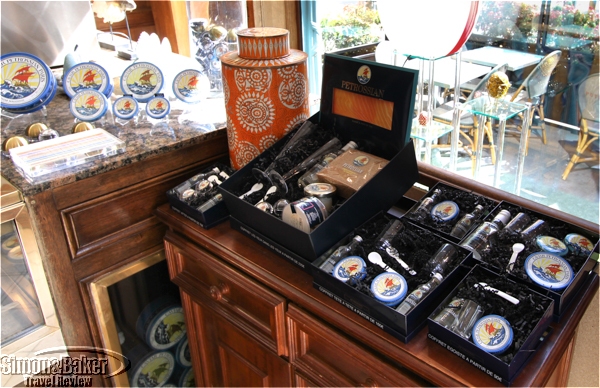
There were gift packages to accompany the caviar
Established in 1920 the shop draws local and international visitors the staff explained, saying that many people visit the boutique like a museum and stop to take photos. Some of the staff, including Joseph, Lorna and the owners, have been there for more than 30 years. Everything in the boutique is homemade and fresh, a spokesperson explained by email, adding, “Tourist come from all around the world because they know Petrossian. They want to bring back home a little souvenir, a little gift, and most of the time, they choose caviar because we offer them a cool bag with dry ice inside and they can travel with it.”
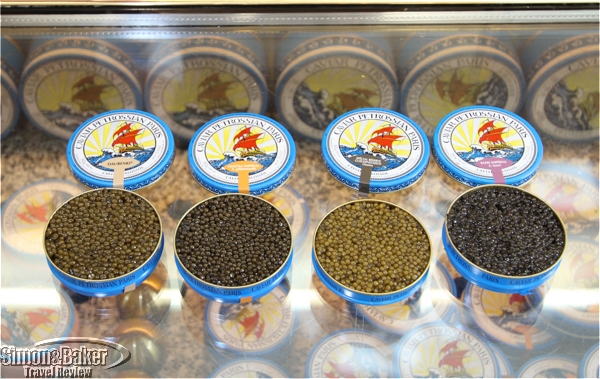
The staff person selected a single bite for our tasting from four caviar varieties sold in the metal containers pictured above
We liked the opportunity to sample the delicate products with the guidance of experts so that the caviar we tasted was at just the right temperature and optimum conditions. Too warm and the flavor is spoiled, too cold and it fades, the shop employee explained. The ideal temperature to taste caviar is between 6 and 8 degrees Celsius, he said. Being able to compare and contrast the nuances from one type of caviar to the other was an added advantage as it allowed us to form an opinion from the single tasting serving without having to purchase and prepare a tasting at home.
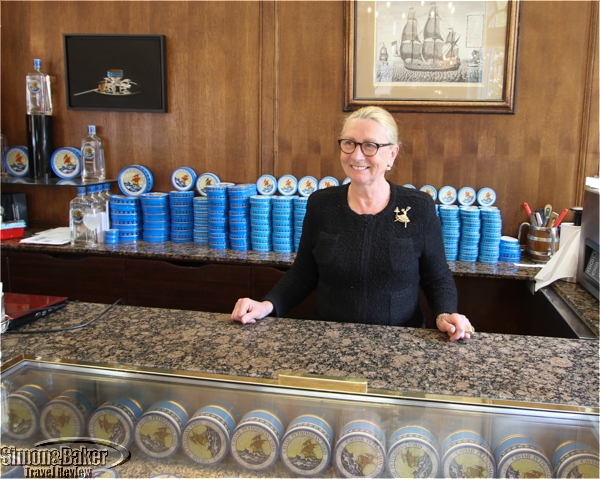
Cécile Petrossian supervised the tasting
We began the gourmet experience, under the supervision of Cécile Petrossian, Armen Petrossian’s gracious and elegantly attired wife, with caviar. While we watched our host pulled out tins from the glass counter before us, explaining the basics about the caviar, which was between eight and twelve months old. He used a special key to open the large cans such as a two kilo Ossetra Reserve container filled with plump sturgeon eggs he showed us before retrieving our sample from a small tin. Philippe handed each of us one serving of several types of fish eggs on disposable wood sticks, explaining wood and mother of pearl are commonly used to avoid distorting the delicate flavor with metal spoons. We were surprised at the slight variations in color, texture and taste of the caviar samples, light and smooth yet each with a distinct characteristic. One was dark, almost black with a hint of fish and salt. The Ossetra Reserve was dark gold and more defined. The Ossetra Impérial eggs were firmer than the Ossetra Reserve with a more pronounced flavor. And the final sample, also with a gold hue, reminded me of the sea yet had a fattier yet subtle taste.
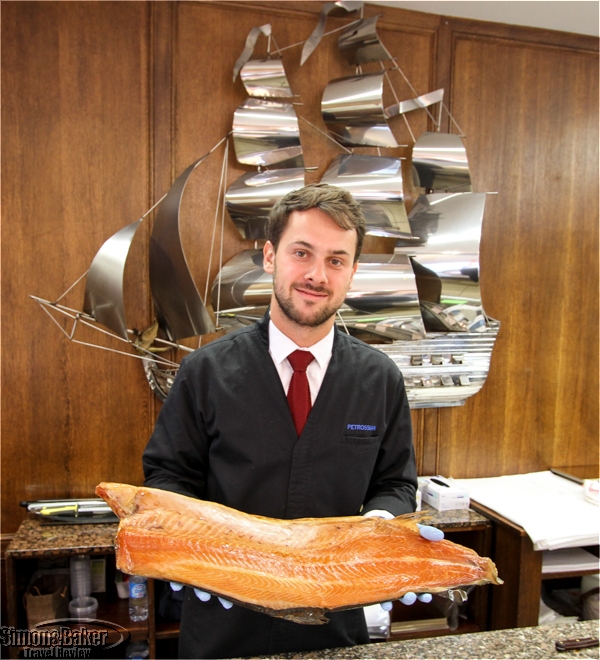
Phillipe displayed a smoked salmon chunk before slicing a sliver for our tasting
At the conclusion of the caviar sampling, we crossed to the opposite end of the shop to the salmon counter, where we sampled several flavors such as Caucasienne, Nature, and Bettrave. All were buttery in texture and seemed to melt in the mouth. Philippe explained their salmon was smoked and aged hanging so the excess fat could drip naturally and allow the remaining flavor enhancing fat to cling to the fish, lending it a rich yet understated taste and texture. We sampled the salmon “tenderloin” in three flavors. The Nature salmon was just that natural. The Caucasienne was prepared with a rub of 12 spices. And the Bettrave was colored with beetroot juice, which made it look like raw tuna. To crown the experience Philippe handed us a bite of Kamtchatka Crab followed by a dollop of the house tarama (fish egg spread).
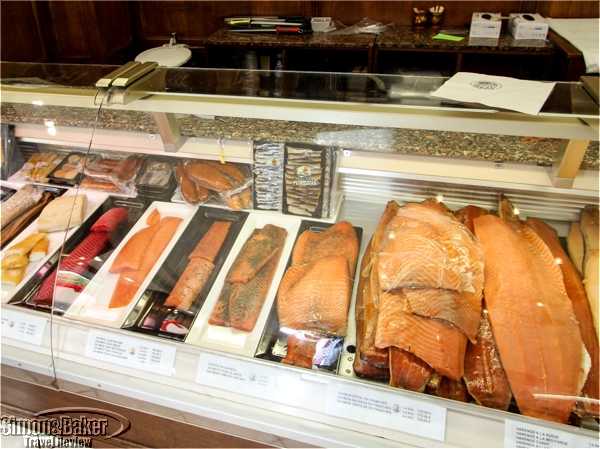
Several varieties of salmon, some with special marinades like beet root

There were prepared specialty foods
We liked the shop’s caviar and salmon selection and expertise and will recommend it to friends wishing to taste the specialty foods in a gourmet environment. The staff’s warm service in English enhanced the experience and would draw us back easily.
by Editor | Dec 15, 2014 | Food and Wine, Restaurants and Food
By Elena del Valle
Photos by Gary Cox
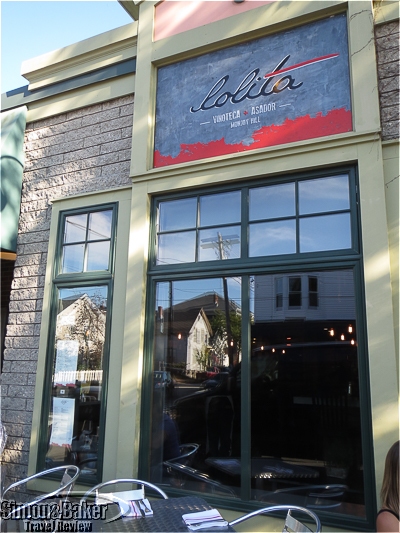
The exterior of Lolita Vinoteca + Asador
Lolita Vinoteca + Asador (90 Congress Street, Portland, Maine 04101, +1 207-775-5652, http://www.lolita-portland.com/, info@lolita-portland.com), a few blocks past the Portland Observatory on one of Portland’s main streets, was easy to find. Maine’s coastal city had many dining choices from exotic to exclusively local. Lolita, established by Guy (executive chef) and Stella Hernandez and Neil Reiter was the only Spanish themed tapas eatery with a wood fired oven we came across. The 900 square foot eatery with a staff of 12, table seating for 20, and space for 10 at the bar opened its doors in June 2014.
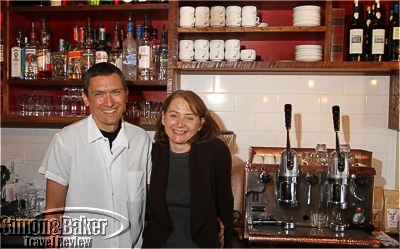
Guy and Stella Hernandez
The menu, described as “American cuisine, guided by Mediterranean and old-world traditions,” featured small plates and plates to share with specialty dishes from the wood-fired grill and meats from the eatery’s antique prosciutto slicer.
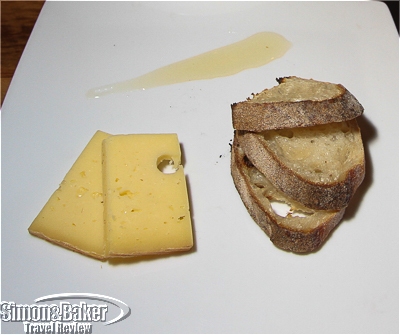
Bread, honey and Consider Bardwell cheese
Prior to Lolita, Guy and Stella owned and operated Bar Lola for seven years. Lolita is a reference to that previous establishment in that the Asador where we had lunch was smaller and less structured than Bar Lola had been. Vinoteca, or wine facility in Spanish, referred to Stella’s wine and beverage background. There was a list of 75 wines featuring classic wine regions and varietals, as well as unique selections from around the world. Plans were in place for an extensive by-the-glass program with full, half-glass and flights options. Asador, referring to an establishment that features food cooked over an open fire in Spanish, highlighted the custom grill in the open kitchen.
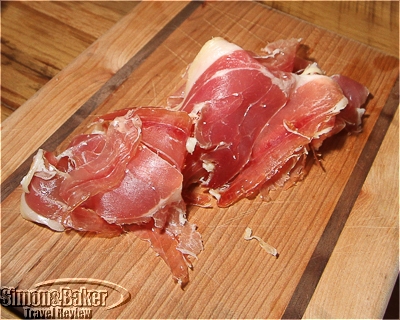
A serving of thinly sliced Serrano ham
Before entering the restaurant industry, Guy held a number of teaching positions in architectural design and technical drawing. In 2006, before opening Bar Lola, Guy was a baker at the One Fifty Ate Bakeshop in South Portland, and assisted with the launch of Scratch Baking.
Stella, general manager and beverage director at Lolita, had more than a decade of experience in the hospitality industry. Prior to working at Lolita, she held the same positions for Bar Lola. She was a member of the Guild of Sommeliers and was taking Court of Master Sommeliers education courses. Stella and Guy were the owners of Hilltop Coffee, nearby.
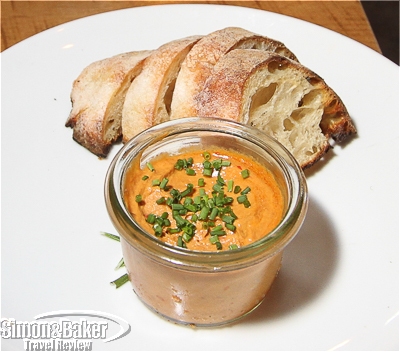
The Sardine Rillette pot with bread
Neil’s passion for the restaurant industry grew out of his experience as a silent partner in several successful New York City restaurants and clubs. Previous entrepreneurial experiences included founding and being president of Reiter Marketing Group, Inc., and R & J Partners, LLC.
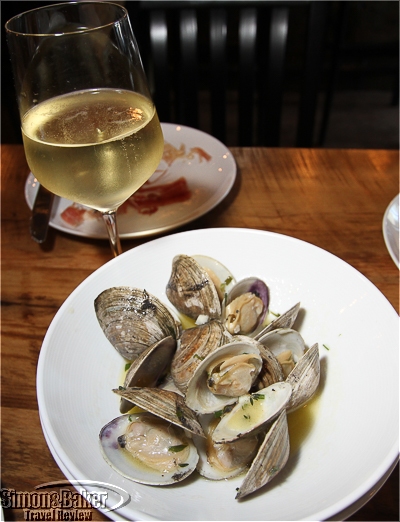
Our order of Wood Roasted Clams
We liked the casual contemporary decor with post industrial features, as well as the friendly and well informed, if slow paced, service. Mostly we enjoyed the food. We sampled a variety of the dishes: Thinly sliced Serrano ham from La Alberca, Spain; the day’s special short rib panino; Consider Bardwell, a West Pawlet, Vermont cheese; local Wood Roasted Clams (a favorite); Spicy Sardine Rillette, served in a pot with roasted slices of bread; Grilled Romaine served with Tarragon Vinaigrette and Pecorino cheese shavings (a favorite); and a homemade Apple Tarte Fine for two. We washed it down with a glass of cava and a pale ale.
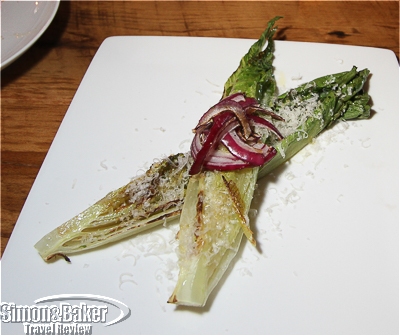
The Grilled Romaine
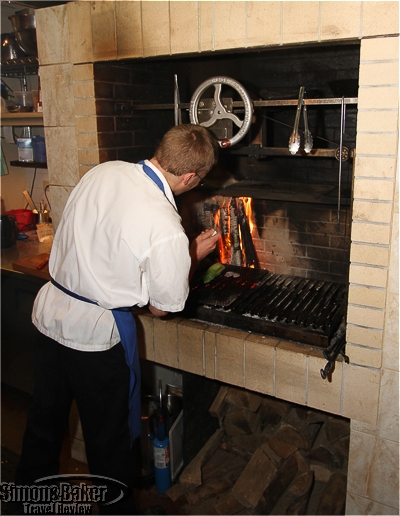
One of the staff making Grilled Romaine in the Asador
Our only complaint? Parking was difficult to find in the residential neighborhood of Munjoy Hill. It took us ten or more minutes of circling around the eatery to locate a parking space two blocks away where we hoped our car would be safe from the tow trucks announced on many city signs.
by Editor | Apr 28, 2014 | Food and Wine, Restaurants and Food
By Elena del Valle
Photos by Gary Cox
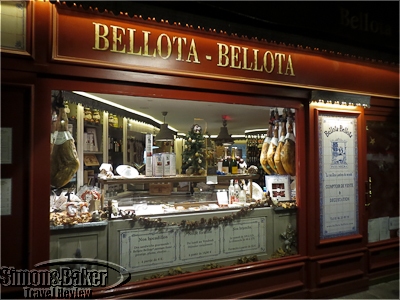
Bellota Bellota in the Latin Quarter (click photo to enlarge)
On a recent trip to Paris, France we ventured to Bellota-Bellota, a new gourmet shop with on site dining in the Latin Quarter (Bellota-Bellota Saint Germain, 64 rue de Seine, 75006 Paris, France, +33 1 46 33 49 54, www.bellota-bellota.com, aszabo@bellota-bellota.com). From the sidewalk we could see through a large display window. The distinctive azulejo tiles and hanging hams in the decor were a sign of the treasure trove of domestic and imported goodies housed inside. When we first arrived in between meal times we had the dining area and shop mostly to ourselves. Despite the touristy location there was a steady trickle of French customers picking up supplies to go. Such was the case with two gorgeous poodles who were as fond of the shop’s famed dry aged distinctive hams imported from Spain as their owner.
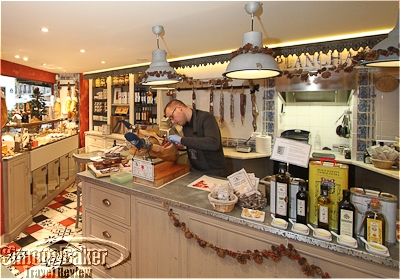
Watching the Bellota slicing is part of the fun
We relied on the staff’s knowledge and advice in our extended late afternoon tasting. We started with the shop’s seafood products. First, there were three varies of Tarama (a creamy spread made with roe), natural, lobster and truffle. We were lucky to be able to sample them all. The server explained they didn’t always carry the lobster Tarama. The wild Alaska salmon eggs were non pasteurized (though previously frozen). The sliced-by-hand Norwegian salmon, farm raised in an area with many currents, was memorable. Double smoked in Germany with elderwood it had a rich, well rounded flavor without greasiness.

The three varieties of Tarama we tasted
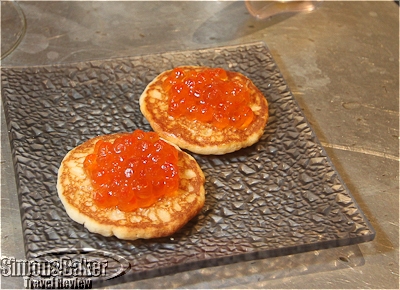
Wild Alaskan salmon eggs
Spanish pork products were next. Gijuelo, a 58-month chorizo, Fayet from Catalonia (from a Celtic pig), lomito (pork loin from the end of the filet), and lomo, pork loin aged 20 months and vacuum packed, were next. The Fayet, somewhat hard and aged, was flavorful. Although we enjoyed all of them the lomo was our favorite. They were served with a homemade tomato blend of French tomatoes, garlic, olive oil, and salt flavored with rosemary, thyme, basil and laurel.
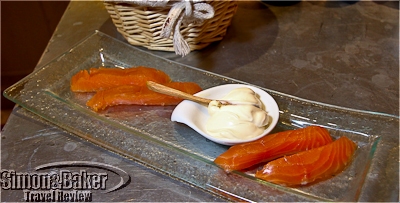
Two different cuts of the Norwegian Salmon
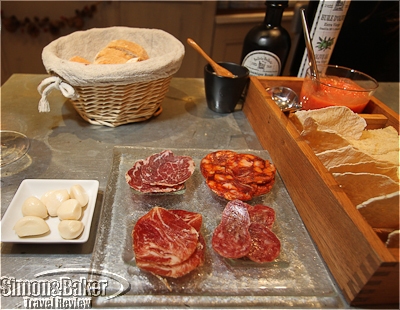
A selection of Spanish pork products with crackers and homemade tomato dip
A volcano shaped dish designed by Bernardeau on Limoges porcelain was born from an idea by Phillipe Poulachon, the Bellota-Bellota founder. The plate had space in the middle for a votive candle to gently warm the fragrant bellota ham in order to enhance the flavor. The warmth of the candle, a staff member explained, should make the fat of the ham translucent at 28 Celsius, the ideal temperature, and display the product to its best advantage. We sampled pata negra Grand Crus from the Guijuelo region of Spain and Bellota-Bellota from Huelva and Jabugo. The small portions disappeared as if by magic from the table. It was served with crystal bread without leavening.
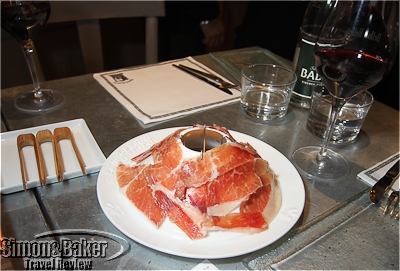
The special volcano shaped serving plate (click photo to enlarge)
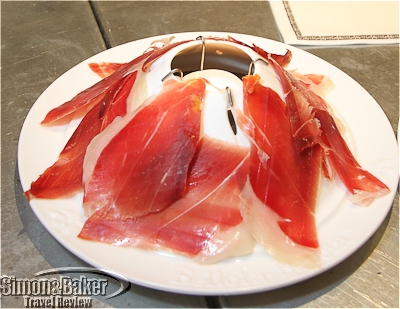
A different cut of meat on the volcano (click photo to enlarge)
The bellota hams were selected from among the best produced in Spain, the shop specialist explained. The company trained its staff to identify ideal hams by using a horse bone, known as a cala, to pierce the seven veins in a pork leg. He demonstrated the process on one of the ham legs in the shop, inviting us to note the variations in the different hearty vein smells. Thirty percent of the original weight of the pork meat is lost to the dry aging process, he went on to explain. Some studies in Spain, he mentioned, suggest the oleic acid in the pork may be good for heart health.
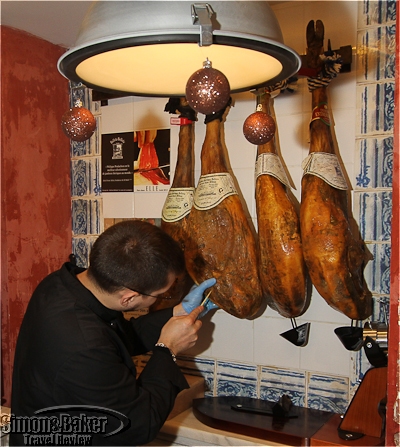
The staff demonstrated piercing the ham to check the curing process
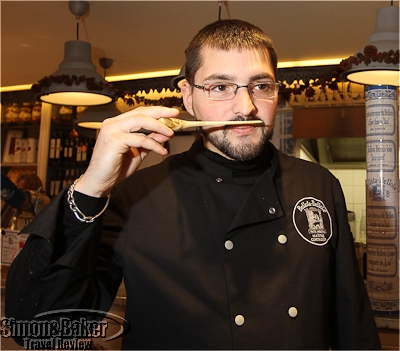
The scents of the ham from different testing points were intense
We also sampled delicious Pluma de Pata Negra rare grilled steaks with a heavenly scent prepared at the shop. They were made from frozen as only 600 grams of pluma were produced from each Iberico de Bellota ham, the staff person told us. They were tender and oh so flavor filled. They were served with Pimientos de Padron green peppers (also from frozen), and mashed potatoes with olive oil.
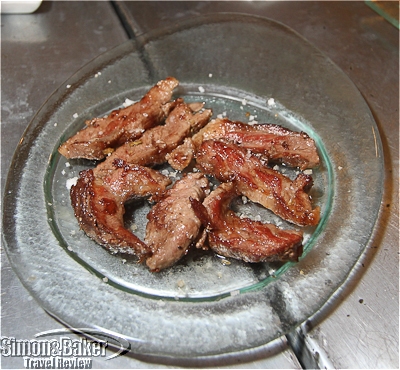
Pluma de Pata Negra rare grilled steaks
Sharp cheeses from Spain, that matched the powerful deli meats, closed the savory portion of our tasting menu. There were two types of manchego and a torta d’Extremadura from Salamanca. The strong Extremadura cheese, made with raw ewe’s milk, was aged 60 days and turned by hand daily. The cheeses were served with quince jam.

Manchego cheese with quince jam
The staff selected Spanish wines to match our tasting: Pago Vallegarcia made from 100 percent vignior from Toledo, and a red Bassus Premium, a spicy blend of bobal, cabernet sauvignon, shiraz and petit verdot grapes from Utiel Requera from Valencia; a red 2007 Coma Vella (priorato) made with grenach, cabernet sauvignon, carinera, syrach from south of Barcelona. To complete our tasting, we had Spanish turrones (nougat) from Alicante and Girona followed by French Madeleine pastries made with honey harvested by handicapped artisanal makers from Les Cevennes, France.
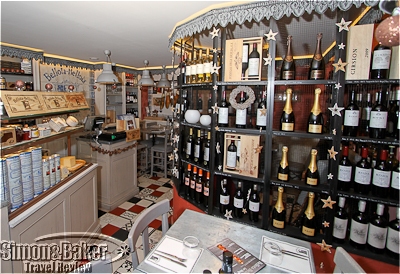
A selection of Spanish wines and champagne was available
From beginning to end the tasting was a delight. The cheeses, salmon, Tarama, and salmon eggs were free of preservatives. Our favorites were in no particular order the double smoked salmon back, the 20-month aged lomo and the aged Bellota-Bellota Grand Cru hams.
by Editor | Jan 20, 2014 | Restaurants and Food
By Elena del Valle
Photos by Gary Cox
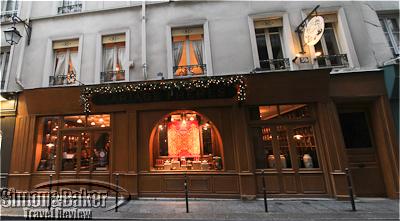
The Mariage Freres Marais shop and tea room
On a chilly winter Friday we skipped lunch in order to sample the offerings, in the late afternoon, at Tea Salon Mariage Freres Marais, a popular tea salon (and shop) on the Right Bank of Paris, France. While we were well acquainted with the company for its eternally crowded street facing tea shop it was the first time we ventured into the 150 meter establishment behind the shop. The tea salon, which occupied space on the ground and first floors and employed 20 staff, could accommodate up 32 people.
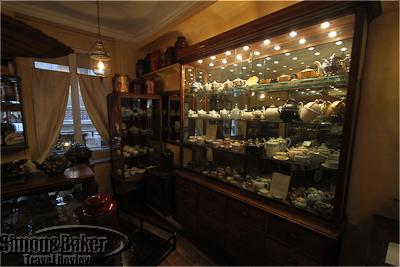
A collection of teapots from the tea museum
Before sitting down, we took a few minutes to climb up a narrow spiral staircase on the left side of the shop to a first floor tea museum where the company displayed items from the early days when the founders, Henri and Edouard Mariage, traveled the world in search of tea, as well as antiques donated by clients and friends. We were on the site of the original shop from the foundation of the company in 1854, a staff person explain.
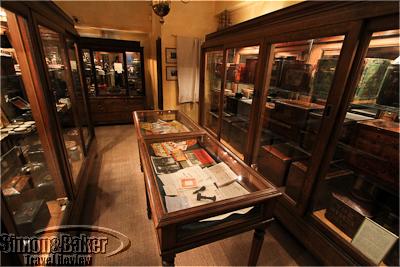
Documents and memorabilia of Mariage Freres early days
The Marais tea salon we visited was established in 1986. Over the years, three others opened their doors in Paris: Mariage Freres Rive Gauche, 13 rue des Grands-Augustins, 75006; Mariage Freres Louvre, Carrousel du Louvre, 99 rue de Rivoli, 75001; and Mariage Freres Etoile, 260 rue du Faubourg St-Honore, 75008.
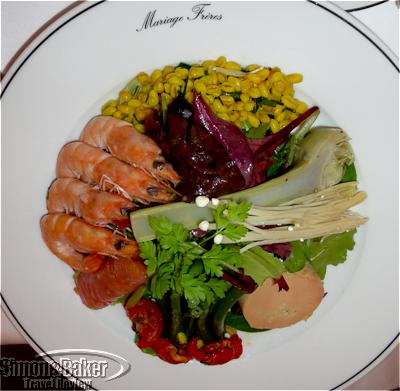
The Snob Salad (click to enlarge)
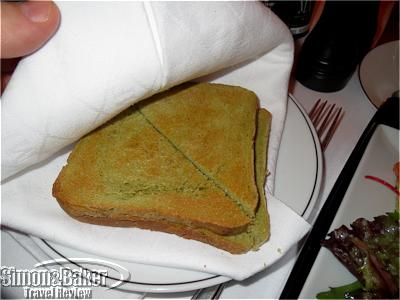
Delicious match toast were served with the Snob Salad
In the tea salon, as in the shop, young men dressed in tailored pale linen suits, provided attentive and polite service. A limited menu was on offer from midday into the early evening. On the ground floor, the rear wall featured a tea canister display and counter. Small tables scrunched together in groupings of two or more made up the rest of the salon. A glass ceiling allowed the dim winter light in, making us wonder how pleasant the room would be in spring. After taking our coats one of the servers escorted us to a table on the right side of the room. An English speaking server provided us with a house copy The French Art of Tea which featured information on the nearly 700 teas on offer.
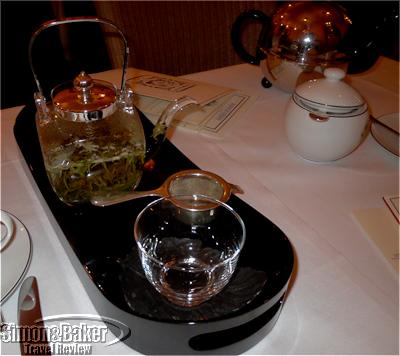
In the foreground, the glass teapot and glass teacups in a black tray while the more common teapot is in the background, filled with Marco Polo black tea
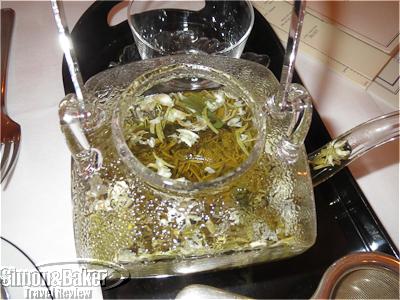
The Neige de Jasmin (Jasmine Snow) green tea was served in a glass teapot
I had a Snob Salad and my companion had a Nostalgie de Pondichery, both house specialties. His dish was served only between 3 p.m. and 6:30 p.m. It consisted of an assortment of mini sandwiches: duck foie gras, Empereur Chen Nung flavoured smoked chicken, Vert Provence tea flavoured vegetables, mini smoked salmon croque monsieur served with tea and a pastry from the Chariot Colonial. The Snob Salad consisted of duck foie gras, smoked salmon, shrimp, enoki mushrooms, saffron wheat, haricots verts (green beans), violet artichoke hearts and mesclun, Paris-Singapour tea vinaigrette, and Matcha green tea toast covered with a napkin and served on its own plate. On a subsequent visit, we ordered the Snob Salad (I couldn’t help myself), and a Louvre Club sandwich with smoked chicken, fromage frais flavoured with Empereur Chen Nung tea and coriander, crushed tomato spread, mesclun side salad with toasted pine nuts and bacon with tea and a pastry from the Chariot Colonial.
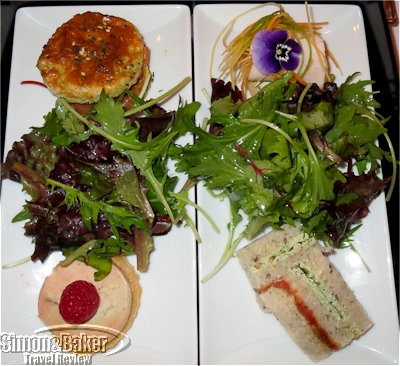
Nostalgie de Pondichery, a selection of tea sandwiches (click to enlarge)
Selecting a tea was a daunting experience given the vast selection on offer. On our first visit, we shared two types of tea. First, with the savory course, we had Neige de Jasmin (Jasmine Snow), a delicate green tea with Jasmin blossoms from China served in a glass tea pot. Glass tea pots were reserved for “spectacular teas” such as yellow teas, teas with flowers or teas with silver or gold, a staff person explained.
With the sweet course we had Marco Polo, a black tea with a mysterious blend of fruit and flowers from China and Tibet. There was also a Marco Polo Rouge made with red tea although we didn’t sample it that day. The Marco Polo was served in a French ceramic pot with a metal cover which kept the tea hot for up to one hour. A tea pot consisted of four cups of tea. Those with the tea leaves still in the pot, like our green tea, could be refreshed with hot water.
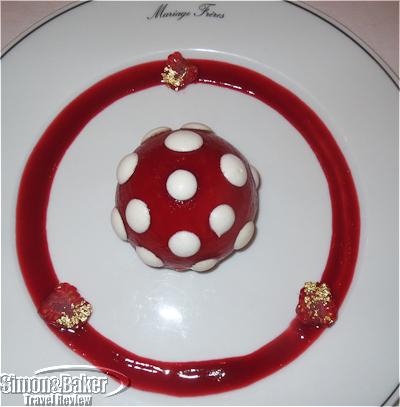
Etoile Mysteriuse Breton shortbread cheesecake with French meringue morsels, and raspberry coulis
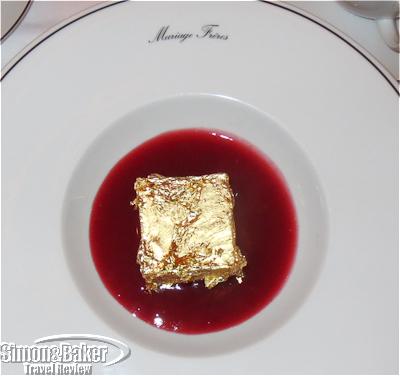
Gold wrapped chocolate in raspberry sauce
We sampled the Carre D’Or 24 carats Dark chocolate entremets flavoured with Black Magic tea, salted butter caramel and chocolate cake wrapped with gold leaf, red currant coulis; Splendeur du Tibet Marco Polo tea infused creme brulee; and Etoile Mysteriuse Breton shortbread cheesecake glazed with “Very Beautiful” Fruit Tea, authentic French meringue morsels, and raspberry coulis. We liked everything prepared by Daniel Milliner, executive chef, and his team.
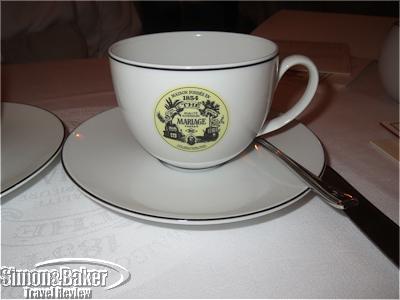
The salon’s teacup was branded as was the dinnerware
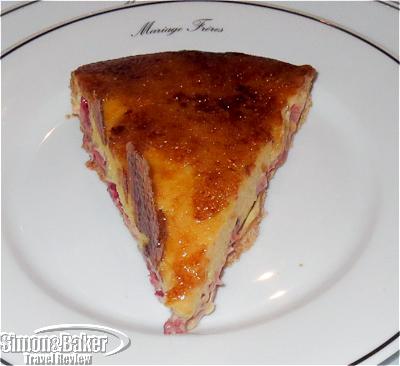
The Splendeur du Tibet Marco Polo tea infused creme brulee was our favorite dessert
The foie gras with the Matcha toast was the most memorable. Of the three salty dishes my favorite was the salad and my companion’s was the Nostalgie de Pondichery. Of the three desserts, our favorite was the creme brulee. We liked the Mariage Freres tea salon because in addition to an intimidating selection of world class teas and gourmet treats it offered us the flexibility of eating at the time of our choosing (assuming there was availability) rather than at the strict restaurant meal times. This was a convenient option when we had a busy day. While the selection was limited the quality was outstanding. We plan to return at the first opportunity. Tea Salon Mariage Freres Marais, 30 rue du Bourg-Tibourg,75004 Paris, France, www.mariagefreres.com, info@mariagefreres.com,+33 1 42 72 28 11
by Editor | Mar 4, 2013 | Restaurants and Food
By Elena del Valle
Photos by Gary Cox
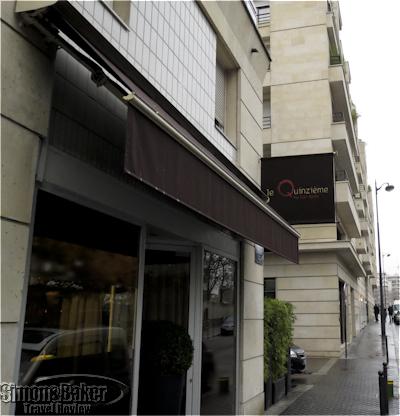
The windows featured a view of the chefs at work
While staying in the fifteenth arrondisement in Paris we had lunch at Le Quinzième Cyril Lignac (14, rue Cauchy, 75015 Paris, France +331 45 54 43 43, www.restaurantlequinzieme.com, resa@lequinzieme.com), named for Cyril Lignac, an ambitious up and coming young chef from the Aveyron region in southwestern France. When he first arrived in Paris in 2000, he worked at L’Arpège, one of the most celebrated restaurants in the city. Only five years later he opened Le Quinzième on the French series Oui Chef! By 2012, he had expanded his culinary company to include bistros, a bakery and a cooking school and received his first Michelin star at the fifteenth arrondissement restaurant.
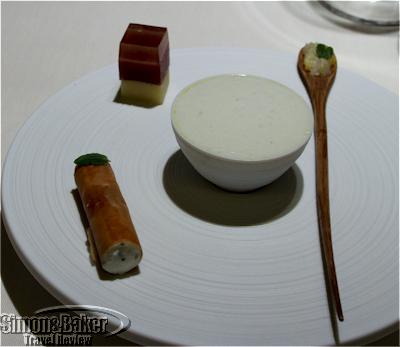
Our bite size starters
To work up an appetite we walked part of the way to lunch. From the street we could see the kitchen staff at work through large glass windows before entering the restaurant from a side street. To reach the entrance we passed through an awning covered terrace devoid of guests on a rainy and gray winter day. Inside, the dining room was beginning to fill up. Brown carpeting, black tiled walls and recessed lights set a cozy tone. Pretty table settings, comfortable built-in sofas and armchairs invited us to linger over our meal. From our back corner table we could glance through oversize glass windows onto the terrace.
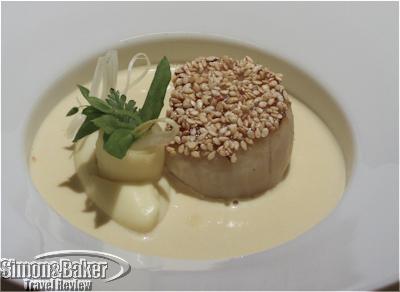
Scallop from Brittany with Tandoori spices
A glass of rose Veuve Cliquot accompanied quince jelly and cheese, crispy goat cheese and chorizo roll, foie gras and white beet root warm cream bite size morsels to start. Smoked salted butter and several types of bread were on offer: crunchy cereal (a favorite), olive, baguette, and thyme and lemon.
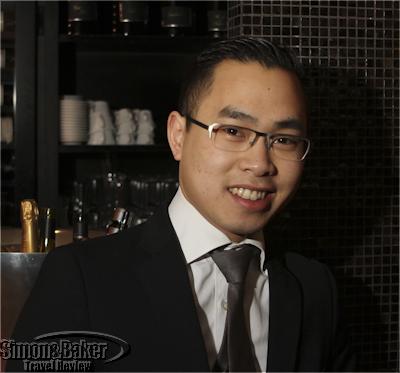
Christophe Tran, manager, Le Quinzieme
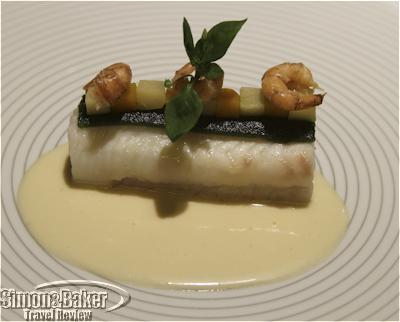
Sole de Petit Bateau slowly baked in herbs Viennoise
Our multi-course meal with four wines was outstanding. We had Scallop fished in Brittany roasted in salted butter with Tandoori spices, fine puree of parsnip and sesame cream; a light and flavorful Sole de Petit Bateau slowly baked in herbs Viennoise, shrimps, yellow wine sauce, Ratte potato puree with vanilla zest; Breton Lobster cooked in nut-flavored butter, green Sechuan berries, flavored potato gnocchi, lobster cream and Parmesan cheese, a winning blend of ingredients that highlighted the lobster without overwhelming it; Tangerine sorbet with fresh mint juice; Beef Simmenthal roasted in semi-salted butter brioche bread-crumbed with foie gras and black truffle that had well balanced flavors served with memorable mashed potatoes; and Roquefort with a poached pear.
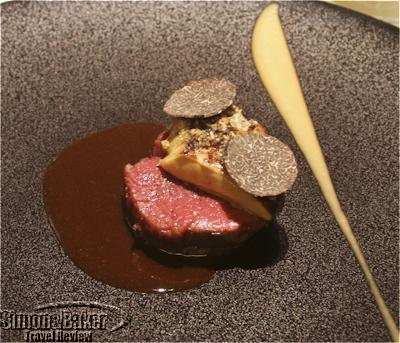
Beef Simmenthal roasted in semi-salted butter brioche bread-crumbed with foie gras and black truffle
For pre-dessert there was Muscovado sugar crumble with lemongrass emulsion, mango sorbet and Bhaba (au Rhum) gelee. Our first dessert, reminiscent of key lime pie, was Lemon from Nice cream and preserved lemon, thin shortbread, and Bourbon flavored vanilla ice cream. Next we had Madagascar light chocolate cream with Tanariva milk chocolate, crisp praline flake and lime ice cream. The staff served chocolates with the espresso at the end.
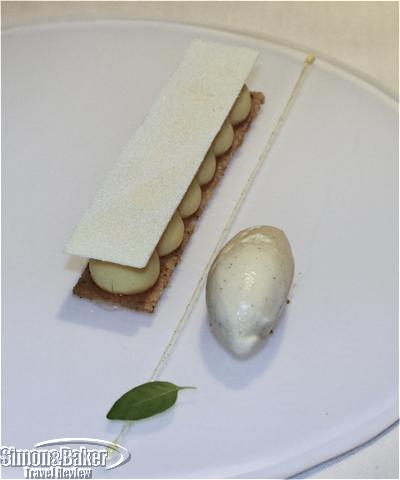
Lemon from Nice cream
Lunch was accompanied by a slightly sweet honey colored Alsatian 2007 Gruenspiel Marcel Deiss, 2010 Chassange-Montrachet Domaine Fontaine-Gaganard, 2006 Saint-Foy Bordeaux Reserve de la Famille Chateau Martet, and 2010 Vouvrey Petillant Vincent Careme.
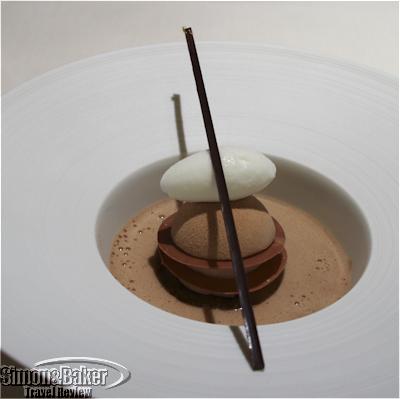
Madagascar light chocolate cream with Tanariva milk chocolate, crisp praline flake and lime ice cream
A well presented and prepared meal that focused on the flavors of the ingredients, attentive service, and a pleasant setting will bring us back to Le Quinzieme the next time we are in the neighborhood.
by Editor | Oct 29, 2012 | Audio, Food, Restaurants and Food
Audio translation by Christine Lissac
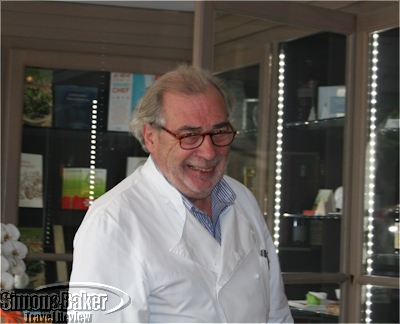
Chef Marc Meneau at Domaine de L’Espérance de Marc Meneau, his hotel and restaurant in Burgundy, France
Listen to a podcast audio interview, in French (see written English translation below), with Marc Meneau, executive chef, L’Espérance Marc Meneau. Earlier this year he discussed his restaurant, one of the best known gourmet French restaurants in Burgundy, and other culinary issues with Elena del Valle, host of the Simon & Baker Travel Review Podcast program, while she was at Domaine de L’Espérance de Marc Meneau in Burgundy, France.
To listen to the interview, click on the play button below
Interview translation:
EDV: So how do you cook?
MM: With love… I begin by reflecting a little bit on the manner in which I was fed in my childhood: with simple products. And I have always kept this traceability of a simple product, never sophisticated with six or seven different flavors in the same plate. I do not know how to do that.
I began to cook later in life after marrying a beautiful blonde whose parents were in the restaurant business and whose mother was a chef and so my wife coaxed me along that line. Eventually we began to consult cookbooks together. I was not a cook back then; we selected some recipes, some words, we did comprehensive research and it was with a document we wrote that we taught ourselves how to cook. And I am still learning, I have been for the past 45 years, I am a perpetual chef apprentice, therefore I observe with great attention all that happens around the world, draw my own conclusions, then continue on my own merry way.
EDV: What are you looking for when you cook? Why do you cook?
MM: Two things need respect. You need to respect the product: if you have carrots, once cooked they must smell like carrots, not smell like cumin or fennel; they must smell like carrots. The second thing is that cooking provides to the one who creates it, the opportunity to share what has been prepared, to present to someone the opportunity, the pleasure of eating well.
I believe these two things are of equal importance. Sometimes the product is more important, sometimes giving to others the pleasure to eat is more important. I have to admit that this inspires me to constantly come up with new recipes, invent new dishes. It is like walking along a little country road leading to Mount Olympus that I will never reach because my arms are too short.
EDV: How do you see this path of yours? The past and the future, as a French chef, what do you see?
MM: My motto is to only think about only 15 minutes into the past and to see the future over a period of a hundred years.
EDV: And what do you think about French Cuisine in the world?
MM: There was a time when French Cuisine was attacked at its very core about 10 years ago, though the one who invented a new form of French cuisine, Adria in Spain, was swallowed up and placed in the forefront in the U.S.A. where the American media thought they had found the world’s genius, without any second thoughts to the possible health consequences that this would have. Adria was a real genius but the public was too interested in “show” cuisines and the media overdid the idea to the point that it became only a Cuisine for Chefs, for those who have fun discovering new flavors, new textures, new technology.
It is not like cooking from memory; it is not like celebrating Grandma’s birthday or your child’s first communion. It is not family cooking; it is a “show” cuisine that was fabulously interesting for us chefs.
Certain French media took pleasure in thrashing out French Cuisine but it was clearly those that were less talented. French cuisine can exist without any problem next to Spanish cuisine, Italian cuisine, Vietnamese cuisine and Chinese cuisine. It is quite possible for all of us to live side by side as our cultures are very complementary to one another.
Each time a recipe exists, there is a story behind it, linked to the culture of each people, each civilization.
EDV: And when you think about what you are doing here in your restaurant, what do you see? Who is the person that is going to be satisfied having a meal here?
MM: This client must be a little like me. He must be someone who knows what a grain of salt and a grain of pepper are and he must also have a grain of imagination; this is how we are going to meet: the client at the table and me at the stove, giving someone an emotion that will become a memory in his life and remind him of his childhood. He could say “yes I have tasted carrots prepared this way with a similar taste twenty years ago.” Even if it is not exactly the same the important part is the memory retained at the time. This is how cuisine becomes a revealing mechanism of life’s emotions.
EDV: Does that person need to be French?
For millennia now cooking has become an international thing, it does not have a country, a color, it is only the expression of how people live on a particular territory. Life is lived differently whether you live in Africa, Asia Minor or Northern Europe. Therefore each country will have its own traditions.
Here is a simple example: Meat can be grilled using old vine logs or pine wood from the moor, birch wood from the northern country and all these will produce a different flavor. There is going to be identification by methodology that will create a different taste.
EDV: So how do you know how to choose this or that place?
MM: Well that is a choice to be made.
EDV: So we ask advice from the chef. What is the style that you produce in your kitchen?
MM: In order to give advice one has to know the people asking for it. The first time you meet them it is impossible to know them. Therefore one must have clients that become patrons so that after their third visit, their host knows that they like eating ris de veau or prefer a turbot fish to a lobster. All that forms part of the professional experience of those working in the restaurant’s dining room. This is no longer the work of the chef. The chef cooks the type of cuisine that he likes and if some people like his type of cuisine, it is all the better. If some people do not like his cuisine, well then either he commits suicide as Vatel did or he changes his range.
EDV: Would you say that this is Classical French Cuisine?
MM: It is the cuisine of Marc Meneau
EDV: Is it not possible to describe it?
MM: No. Not possible.
It is neither classic nor modern; it is the way people like to eat these days while experiencing an emotion. Whether they only want to eat one dish, prefer to eat quickly; there are appropriate dishes for them to choose, and if they would like to have a feast there are also dishes appropriate for that, if they wish to spend an enjoyable evening, between friends or as a couple, there are dishes suitable for that too. No rules.
EDV: The products – Because we begin with the products – what can you tell me about them?
MM: Without product there is no cooking, one does not need to be a good cook if one has rubbish products. One must only use the best products: good products draw out the chef’s intelligence because once the chef has the notion of the effort required to produce these good products and the respect they deserve he will not cheat with them.
EDV: How do you go about getting good products?
MM: We have a lot of experience in this profession and we personally travel across France ten times a year looking for products.
EDV: And what is available here?
MM: Here we have a countryside blessed by the gods as far as architecture, literature, music, history is concerned yet we have rather humble products with the exception of meat, the Charolais (bovine) and of the river fish, which people do not eat anymore, they don’t like it; these days, people do not eat river fish anymore for a single reason: fish bones, sea fish have less bones.
So, as far as foie gras is concerned, we don’t have any here, we only have ham, we have mushrooms. We are limited in what we have but on the other hand we have fresh herbs every day and condiments of good quality. So we find ham in Spain, foie gras either in Landes or in Alsace. We find poultry in Bresse.
EDV: And this morning you took me to visit… the vegetable garden. So what can you tell me about the vegetable garden?
MM: The vegetable garden is a virtual calendar developing in my head; and when I see the first radishes coming through, the leeks, the first lettuces, the zucchini, the eggplant, the tomatoes. Walking through the vegetable garden every day gives me ideas and inspires me to cook. It is a trigger for ideas and inspirations and at the same time it positions me within the right season, so I almost become an honest man.
EDV: And so you have to work hard to get the products from your place? I believe you have two employees in the garden?
MM: Yes, two employees take care of the garden to allow us to have a beautiful garden with flowers, agreeable and simple without sophistication, and a vegetable garden which will bring back to the minds of those strolling by, memories of their grandmothers, their parents, prompt that get them to recall visits to some beautiful castles. Most importantly, they will begin to think to themselves: “rather than having caviar for lunch I am going to have some of these good old radishes with fresh farm butter,” radishes that would never have seen the inside of a fridge, that would not have been transported by truck and that would have been picked that same morning. That is true luxury.
EDV: Do people appreciate it? Do they realize that when they come and sit at your table?
MM: Yes, we are in a period where people are in the process of rediscovering vegetable gardens and leisure gardens and I encourage everyone who has a little balcony or window to plant a few things there. I think it is awesome … because we know we have a rotation over about 20, 40 days in a year, one can have fun by planting a few lettuces, a few carrots, a few radishes, and the day that you are going to eat your own vegetables, it is going to trigger an explosion of joy which will get you to think “I know why I am human, I know why I live.” My dog is unaware of this.
EDV: This is only available to humans…
MM: To mankind… the privilege of humanity is to have the sense of taste, not intelligence, taste. I don’t think other animals have a sense of taste. We do, we have a sense of taste.
EDV: What is the biggest challenge for you, and for a chef today?
MM: It is to stand firm against all the commercial offers of bad products. Recently a great French label of nutritional products, offered with a lot of colorful pages, some truffles all chopped up with gold leafs mixed in, saying that it would make a dish of risotto or rice “chic” when adding this very expensive product that is actually useless. Either we have truffles or we have gold. Gold is for festivities but it is not nutritious. So one has to resist the pressure of the clients who want to pay less and less for their food because they have so many other financial commitments that did not exist twenty or thirty years ago, but they are all so trendy, to the point that these days the cost of food for consumption is lower. So it is up to us chefs to find a solution to reduce the cost but not at the expense of quality, rather by stimulating our creativity and knowledge and harmonizing them in a recipe that could be very simple as long as it is made with good old products. Flashy components are no longer necessary as they used to be in the eighties and nineties, where one had to eat lobster, caviar, foie gras, etc. That era is over. If we do caviar now it will be an eggplant caviar, no longer the caviar from the sturgeon.
EDV: Why?
MM: Because it is no longer in fashion! The price is not justifiable. Twenty or thirty years ago, the cuisine was … how could I say…a social entertainment, today it is an introspective entertainment: how am I going to eat well, how am I going to avoid processed food that we don’t really know much about like how it is produced. How am I going to manage that? How much time can I invest in my cooking in order to avoid the bland ready-made meals with their standardized taste? There are colorants, artificial sugars in each processed product. People are beginning to discover that when a product is natural it is a little less like Coca Cola.
Because when we have a glass of Coca Cola we need a second one. Where as if we drink an ice tea for instance, it is not necessary to have a second one. This is the difference and therefore the cuisine is going to become like that, an element of cultural sobriety.
EDV: Do you think it’s going to be like that in the near future in five or ten years?
MM: Yes I think so. There will always be …. and this is specific to France…upstream from the chef, people that are producing exceptional products. Those that farm and breed are contributing to the greatest wealth of our culinary capital. Today I believe that carrots or tomatoes farmed through extensive agricultural methods are going to lose ground, they will be less and less chosen for cooking.
EDV: What do you mean by extensive agricultural methods?
MM: It is producing farm products in very large quantity using fertilizers. And I think that we are going to return to the original way of farming fresh products.
EDV: I see, cheaper in higher quantity…
MM: Yes that’s it… because a very big tomato cost one euro and three average size tomatoes cost one euro, and when you eat a big tomato from the garden it is more than enough to satisfy your hunger. You would need three badly cultivated tomatoes to make up for that and you spend the same amount of money.
EDV: Are young people able to recognize that?
MM: Young people educated in that discipline can. As for those who are not… I don’t know what we are going to do with them. I would advise parents to set aside one hour per week cooking for their children, to rediscover life around the table and discussions around a meal where one would say “I bought these potatoes last week while we were away at such and such place…” and they will know they are eating those particular potatoes. So, to have gone out to buy the potatoes, brought them home and stored them in the best possible way until the time comes to peel them and cook them, this calls for respect and those potatoes will not be eaten in the same manner that those purchased from the greengrocer downstairs, or in town, that’s if we cook them in water…if they have not been bought already prepared.
So I believe that people have to return to the way things were. In the eighties, some architect designed kitchens that look like lounges. We need to go back to the homely kitchen.
EDV: Some people say that chefs are artists…
MM: Yes I think so, in a conceptual manner. In the realization of our trade we are artisans and in the conceptual dimension of the research it requires… yes… because we work a little bit like musicians would. They have their musical chords and we have our taste buds chords: sour, sweet, salty, bitter and spicy; with five flavors we make millions and millions of recipes!
EDV: And it is also a visual experience, not only the blending of flavors but you also look after the appearance of your dishes.
MM: Well, nature has provided for us the colors red, yellow, green… blue does not work in food, black, with the exception of truffle and caviar, does not work either. Therefore the color scheme for food remain within primary colors… it is between green, white, red and yellow and that’s where its stops.
EDV: Has the presentation evolved?
MM: Ah yes, presentation has evolved in as much as the portions have become smaller, sauces that were hiding the flavor of food have been removed and replaced by lighter gravies and spices that accompany a dish and they too have become a lot lighter. In forty years, I have witnessed a great evolution, it has been exceptional and with the knowledge I have of France I can say that we have never eaten as well as we do now, never before.
EDV: Recently some people have told me that there were more three-stars restaurants in Japan that in France. Should French restaurants overseas be evaluated in the same manner as French restaurants in France? What is your take on that?
MM: I shall not answer this type of question. Some imbeciles believed that it was better to attribute distinctions outside of the country. It is their choice not mine.
EDV: But the question is: can one eat French cuisine outside of France?
MM: No! The products are not the same. It is heresy. When I see the number of three-star French restaurants in Japan, I say …. pfff! Really, I think those that live in France are truly imbeciles…either that or they do not know the director.
EDV: I also wonder about something else…when I see the work required to own a restaurant, particularly for those that do not form part of a big organization with a lot of money, for those that are independent owners, if you do not have talent, if you do not do a great job… you won’t make it.
MM: Yes, it’s the end for them. There are two types in our line of work that operate at two different paces. There are the great investors and the simple owners like us, those that operate with their heart, their faith and the many number of working hours they invest in it.
EDV: So then I wonder about the next generation… Will they be able to do what you have done? Will they have the spirit to create something out of nothing as you have done with your restaurant? What is your opinion?
MM: So this is a good question, but not one that a man of my age can answer. I can only comment a little about it: the children that have been brought up witnessing all the benefits and all the down sides of our profession will maybe keep in mind the benefits. For instance those benefits will be to be able to go to the Bernardins or Chez Goulue and always have a table ready there even without booking it and not having to pay for it. That is the respect that chefs have between each other. Another benefit is to go somewhere and receive a medal. That makes us proud because after all we are “dramatic” people. After spending 15 hours a day in our business, sometime we love an hour during which we can enjoy being the little king of the moment. I have no problem with that. No, I believe it is human nature that causes even a child or another chef to be interested in this kind of benefit. Those unfamiliar with this sort of thing who have access to the position via cooking, want to imitate their chef. It’s what we call motivation. It’s what we call in French la niaque which means to be strong and determined, with a lot of will power. That person says to himself, “I will do it this way, I will succeed,” and he will in time as his era allows him to. There will always be people with ambition and passion.
EDV: Do you think so?
MM: Yes I do.
EDV: So then there is hope?
MM: Well yes … If we had lived like they did in Russia forty years ago, we would not have had the opportunity to have ambition. But we still live in countries where ambition is not a sin.
EDV: Thank you very much then.





























































